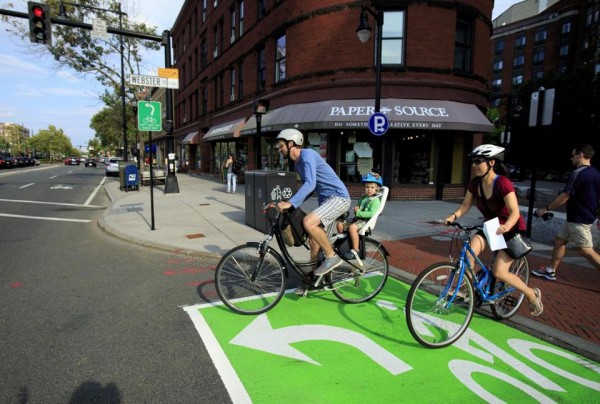Ah, the Boston Globe.
On the one side we have right-wing columnist Jeff Jacoby suggesting that bicyclists should all go for a nice ride in the park and stay off the streets.
Though I’m a registered Democrat and liberal to centrist on most political issues, I often find Jacoby’s columns illuminating. But with this column, he really put his foot in his mouth if he is to call himself a conservative. Conservative about bicycling, to me, means standing up for equal rights to use the road. Liberal would be to advocate for well-designed improvements.
Maybe to try to make up for Jacoby’s rant, the Globe Web site published several photos in early September, 2015, under the headline “five ways to make bicycling safer”. Problem is, the Globe doesn’t know from good design. Some of the photos show bad design. One shows a bicyclist who doesn’t know how to stand over his bicycle. Let’s have a look at each of them.
Photo # 1: “Cycle tracks are exclusive bicycle facilities that are physically separated from motor vehicle lanes through grade changes, parking lanes, curbs, or landscaping.”
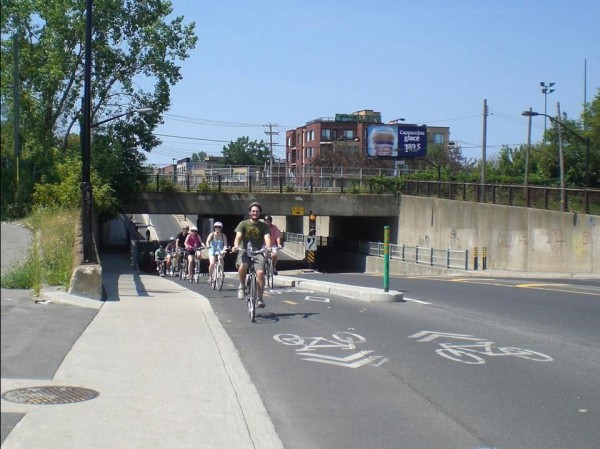
“Cycle tracks are exclusive bicycle facilities that are physically separated from motor vehicle lanes through grade changes, parking lanes, curbs, or landscaping.” Photo by Eric Moskowitz for the Boston Globe
The Globe editors are actually taking the same side as Jacoby, that bicycles don’t belong on the street. Travel lanes in Massachusetts, by the way, are not “motor vehicle lanes”, except on limited-access and express state highways (Storrow Drive, the Southeast Expressway, the Turnpike…).
Nonmotorized vehicles — bicycles, pedicabs, horsedrawn wagons (and yes a company runs these for tourists in downtown Boston) are permitted on streets, even one with a separate bikeway running alongside.
The photo shows a two-way one-side-of the street bikeway under a railroad bridge, in Montreal — Google Street View identifies the location. The overhead Google Earth view reveals that this is along a route which partly is on paths in parks, but mostly runs alongside streets.
Exclusive? Physically separated? Because of the descent to go under the bridge, bicyclists pick up speed, and two-way travel in this narrow space is more hazardous. Separation consists of a curb which will topple a bicyclist into the adjacent travel lane. In the foreground, there is no separation, and bicyclists are instructed to ride opposite the flow of traffic in the adjacent travel lane. At night, bicyclists headed away from the camera are facing the bright side of motorists’ headlamp beams — an even worse problem because of the changes in slope. Also there is a driveway at the left, where motor vehicles turn across the bikeway and drivers must advance into a sidewalk past a fence and crane their necks to look for approaching bicyclists. In winter, Montreal’s separate bikeways become unusable and are taken out of service, though a network of designated bicycle routes on low-traffic streets would remain serviceable.
And the bicyclist in the foreground is wearing his helmet tilted back on his head like a sunbonnet. Not a great example.
Germany’s two-way, one-side of the street bikeways have proven extraordinarily dangerous unless on streets with very few, and signalized, intersections. Germany is replacing these bikeways with conventional bike lanes and shared low-traffic streets, making it legal once again to ride in the street, even when there are separate paths.
Also see reports by Jan Heine, publisher of Bicycle Quarterly magazine.
Separate or Equal? — An examination of two-way bikeways in the Seattle area
Despite the European experience, here in North America, two-way one-side-of-the street bikeways are being promoted by the bicycle industry lobby (“PeopleforBikes”) as a safety feature, and the Globe is uncritically beating the drum for this approach.
Photo #2: “A bike box is a designated area at the head of a traffic lane at an intersection that provides bicyclists with a safe and visible way to get ahead of queuing traffic during the red signal phase.”
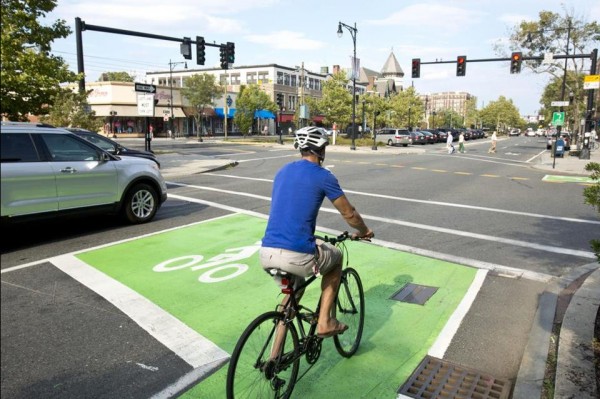
“A bike box is a designated area at the head of a traffic lane at an intersection that provides bicyclists with a safe and visible way to get ahead of queuing traffic during the red signal phase.” Photo by Dina Rudick for the Boston Globe
Thanks to the Lady Grace store on the opposite corner, I was able to identify this location: Beacon Street at Webster Street, in Brookline — Here’s a Google Street View.
A bike box is a safety feature? Visible? It is an invitation for bicyclists to overtake in motorists’ right rear blindspot, placing them in the “coffin corner” where they can be run over by right-turning vehicles, and upon reaching the intersection, to swerve out in front of the first waiting vehicle without any way to know when the traffic signal is going to change. The bicyclist in the photo is shown not using the bike box. Want to see how a bike box in Boston is actually working? Try this.
Photo #3: bicycle signal.
Bicycle signals have good uses, but they need to be used with discretion, because added signal phases can result in unnecessary delay, increasing the temptation to violate the signal for bicyclists and motorists alike. It isn’t possible to tell anything from this photo, though, because it offers no context.
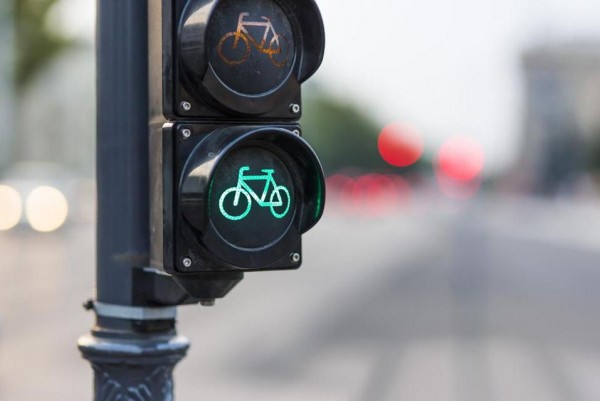
“Bicycle signals make crossing roadways safer for bicyclists by clarifying when to enter an intersection and by restricting conflicting vehicle movements.” Photo by Don Pablo for the Boston Globe.
Photo #4: “Bike lanes designate an exclusive space for bicyclists through pavement markings and signs, and are located adjacent to motor vehicle traffic.”
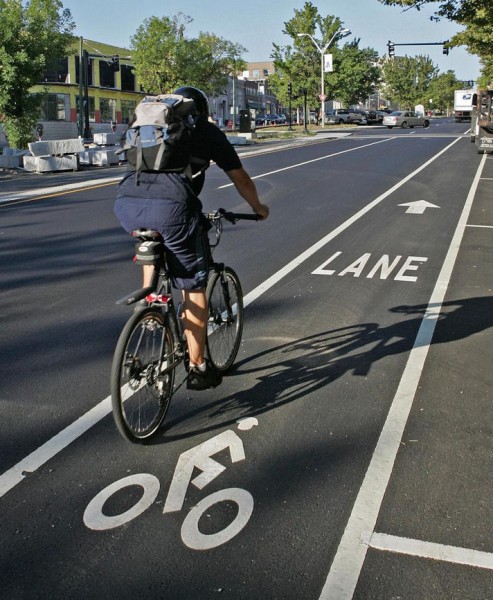
“Bike lanes designate an exclusive space for bicyclists through pavement markings and signs, and are located adjacent to motor vehicle traffic.” Photo by George Rizer for the Boston Globe
There are bike lanes which make sense and there are bike lanes like this one. Exclusive? The bike lane shown, like most in the Boston area, is in the door zone of parked cars. The photograph avoids this issue by showing a section where no cars are parked, however, in the background, a large truck, nearly cropped out of the picture, extends most of the way across the bike lane, so the bicyclist will have to merge out into the travel lane. At least in this way, he will avoid the “coffin corner” at the next intersection. Any law banning trucks from parking in bike lanes will not be enforced, if experience is any example. Another proposal has been for trucks to park in the travel lane outside the bike lane. I’ve said more about this issue, which has seen some attention in New York City, in another blog post.
Photo #5: “Sharrows are road markings that indicate a shared lane environment for bicycles and automobiles.”
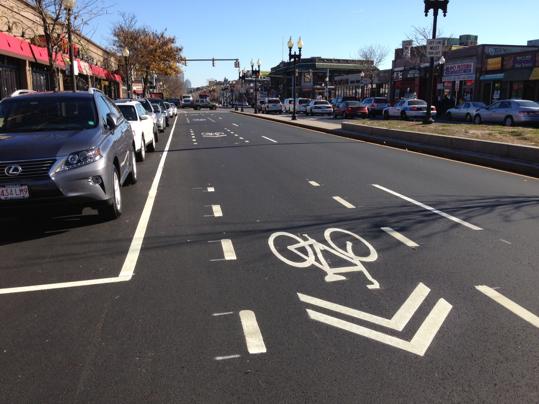
“Sharrows are road markings that indicate a shared lane environment for bicycles and automobiles.” Photo by Martine Powers for the Boston Globe
Not that shared-lane markings should be necessary to indicate this. Sharing lanes is normal. However, shared-lane markings do clarify the situation . I discussed the installation shown in this photo — and even included the very same photo — in another post on this blog, a couple of years ago.
Photo #6: “For more ideas, check out this “bike tool box” at the Cambridge Community Development Department: www.cambridgema.gov/CDD/Transportation/bikesincambridge/biketoolbox”
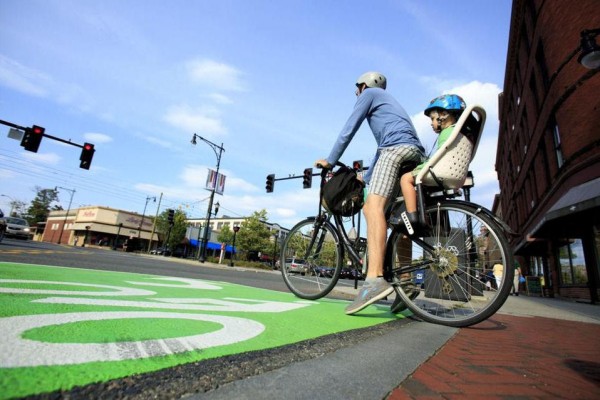
“For more ideas, check out this ‘bike tool box’ at the Cambridge Community Development Department: www.cambridgema.gov/CDD/Transportation/bikesincambridge/biketoolbox.” Photo by Dina Rudick for the Boston Globe
This photo was shot at the same intersection as the one of the bike box, photo number 2, and shows a two-way left-turn queuing box, a useful type of installation if done well. This photo offers a poor example, though: the man risks toppling the toddler in the child seat onto the street, by not knowing how to mount and dismount, and the rear tire of his bicycle is nearly flat. Another photo showing the same cyclist appeared on the cover of the Globe West section on Sunday, September 6, 2015.
The two photos clearly were taken during a staged photo shoot. In my previous post, I asked where the Globe finds cyclists like this for its posed pictures.
The Globe claims that all of the measures it shows in its photos are safety measures. Some can indeed be safety measures, if installed and used correctly; however, much of the infrastructure shown is flawed and some is downright deadly. A cyclist recruited by the Globe to show as an example doesn’t know basics of safe riding. There are better infrastructure solutions as well as non-infrastructure solutions: education, enforcement, etc. Mostly, though the message I get is that the Globe is drowning in its own credulousness.
Save
Save

